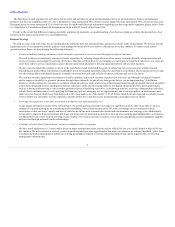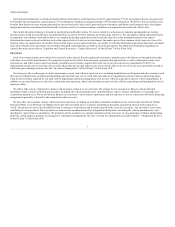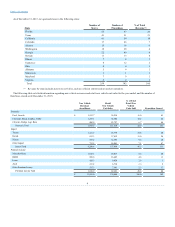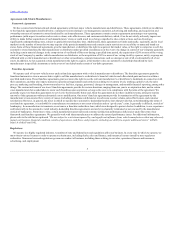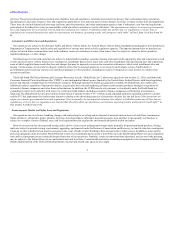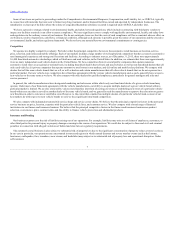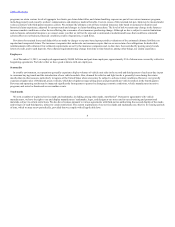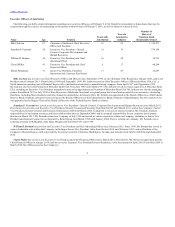AutoNation 2015 Annual Report Download - page 14
Download and view the complete annual report
Please find page 14 of the 2015 AutoNation annual report below. You can navigate through the pages in the report by either clicking on the pages listed below, or by using the keyword search tool below to find specific information within the annual report.
Table of Contents
assistance programs, our ability to collect in full or on a timely basis our manufacturer warranty and other receivables, and/or our ability to obtain other
goods and services provided by the impacted manufacturer. In addition, we have implemented a policy not to retail any new or used vehicle that has an open
safety recall, and as a result, vehicle recall campaigns could materially adversely affect our business, results of operations, and financial condition.
Our business could be materially adversely impacted by the bankruptcy of a major vehicle manufacturer or related lender. For example, (i) a manufacturer
in bankruptcy could attempt to terminate all or certain of our franchises, in which case we may not receive adequate compensation for our franchises,
(ii) consumer demand for such manufacturer’s products could be materially adversely affected, (iii) a lender in bankruptcy could attempt to terminate our
floorplan financing and demand repayment of any amounts outstanding, (iv) we may be unable to arrange financing for our customers for their vehicle
purchases and leases through such lender, in which case we would be required to seek financing with alternate financing sources, which may be difficult to
obtain on similar terms, if at all, (v) we may be unable to collect some or all of our significant receivables that are due from such manufacturer or lender, and
we may be subject to preference claims relating to payments made by such manufacturer or lender prior to bankruptcy, and (vi) such manufacturer may be
relieved of its indemnification obligations with respect to product liability claims. Additionally, any such bankruptcy may result in us being required to
incur impairment charges with respect to the inventory, fixed assets, and intangible assets related to certain franchises, which could adversely impact our
results of operations, financial condition, and our ability to remain in compliance with the financial ratios contained in our debt agreements.
If we are not able to maintain and enhance our retail brands and reputation or to attract consumers to our own digital channels, or if events occur that
damage our retail brands, reputation, or sales channels, our business and financial results may be harmed.
We believe that we have built an excellent reputation as an automotive retailer in the United States. During the first half of 2013, we transitioned our
Domestic and Import stores to a unified AutoNation retail brand. We believe that our continued success will depend on our ability to maintain and enhance
the value of our retail brands across all of our sales channels, including in the communities in which we operate, and to attract consumers to our own digital
channels. Consumers are increasingly shopping for new and used vehicles, automotive repair and maintenance services, and other automotive products and
services online and through mobile applications, including through third-party online and mobile sales platforms, with which we compete, that are designed
to generate consumer sales leads that are sold to automotive dealers. If we fail to preserve the value of our retail brands, to maintain our reputation, or to
attract consumers to our own digital channels, our business could be adversely impacted. An isolated business incident at a single store could materially
adversely affect our other stores, retail brands, reputation, and sales channels, particularly if such incident results in adverse publicity, governmental
investigations, or litigation. In addition, the growing use of social media by consumers increases the speed and extent that information and opinions can be
shared, and negative posts or comments on social media about AutoNation or any of our stores could materially damage our retail brands, reputation, and
sales channels.
We have invested and will continue to invest substantial resources in marketing activities with the goals of, among other things, extending and enhancing
the AutoNation retail brand, attracting consumers to our own digital channels, and reducing our use of third-party online and mobile sales platforms. There
can be no assurance that our marketing strategies will be successful or that the amount we invest in marketing activities will result in improved financial
results. If our marketing initiatives are not successful, we will have incurred significant expenses without the benefit of improved financial results.
New laws, regulations, or governmental policies regarding fuel economy and greenhouse gas emission standards, or changes to existing standards, may
affect vehicle manufacturers’ ability to produce cost-effective vehicles or vehicles that consumers demand, which could adversely impact our business,
results of operations, financial condition, cash flow, and prospects.
Vehicle manufacturers are subject to government-mandated fuel economy and greenhouse gas, or GHG, emission standards, which continue to change and
become more stringent over time. In May 2010, the Environmental Protection Agency and the National Highway Transportation Safety Administration
issued a joint final rule implementing harmonized federal standards for fuel economy and GHG emissions standards, which will substantially increase fuel
economy requirements. These and other laws and regulations could materially adversely affect, particularly during periods when fuel prices are low, the
ability of manufacturers to produce, and our ability to sell, vehicles in demand by consumers at
12


